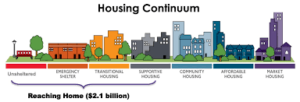Best Practices in Affordable Housing
Introduction:
The affordable housing challenge has become extreme in many communities in recent years and has key implications for smart growth, including for the economic development, transportation, environmental quality, and housing sectors. The evidence about the affordability of housing points to the need for new approaches to creating housing if communities in British Columbia want to continue improving their quality of life. The range of approaches available to address affordable housing concerns, termed the “continuum of affordable housing,” as currently used in British Columbia, and in Canada, is not adequate for meeting the challenge of providing a range of ownership and rental housing in each community.
The purpose of this report is to review the range of affordable housing approaches used by local governments in select jurisdictions in Canada and the U.S. and to provide some preliminary comments about the effectiveness of these tools. This review will provide the backdrop for Smart Growth B.C. to work with other organizations, the development sector, and local governments to develop an affordable housing strategy. This report suggests the need for more robust affordable housing initiatives that reflect the earnings from approaches undertaken in the U.S. since the 1980s.
Methodology:
The investigation for this report commenced with resort communities in Canada and the U.S. These areas have the longest history of affordability challenges in housing a broad demographic within the community. The research then expanded to cities and towns that have seen housing affordability compromised by rising prices and a predominance of single-family housing development.
Affordable Ownership Housing:
Housing with an affordable purchase price to households of low and moderate-income, which are households within the lowest 60 per cent of the income distribution for the housing region, as determined by Statistics Canada. Affordable in this context means monthly housing costs (i.e. mortgage principal and interest payment amortized over 25 years and assuming a 25 per cent down payment, and taxes) do not exceed the average monthly rent for the region, by unit type, as reported annually by the Canada Mortgage and Housing Corporation.
Permanently Affordable Housing:
An affordable single family or multifamily dwelling unit, as defined in the City of Davis Affordable Housing Ordinance, that is affordable in perpetuity and subject to an agreement between the developer and the City to maintain affordability. Such agreement shall be recorded. In the case of rental units, permanently affordable units must be subject to rental screening
Affordable Rental Housing:
Housing where the total monthly shelter cost (gross monthly rent including utilities – heat, hydro and hot water – but excluding parking and cable television charges) is at or below one times the average City of Toronto rent, by unit type (number of bedrooms), as reported annually by the Canada Mortgage and Housing Corporation.
The Continuum Of Housing Solutions:
The provision of affordable housing in Canada has traditionally been structured to meet a continuum of needs, ranging from housing those who need emergency shelter to market ownership. This model of the Housing Continuum from CMHC, acknowledges the objective of affordable home ownership without ongoing subsidy; however, it leaves out the opportunity for non-market ownership, created and managed through housing providers, which do not rely totally on the private sector to deliver.

Policies and Programs for Affordable Housing:
The Policies and Programs are listed below in order of the number of jurisdictions that employed them, with the most popular policy, Inclusionary Zoning, at the top. While the number of jurisdictions that utilize these practices does not indicate how many affordable housing units are generated, it is safe to assume that jurisdictions are looking at what has been successful elsewhere before adopting a given policy.
Secondary Suite Policy:
Secondary suites are an excellent first-stage solution for communities facing an affordable housing shortage. They increase the supply of affordable rental housing, increase the affordability of home ownership (financial institutions take that income into consideration in the mortgage calculation) and provide more housing while retaining neighbourhood character.
Strategies and Tools for Affordable Housing:
This section describes the most utilized strategies and tools for creating affordable housing and lists them below in order of the number of jurisdictions that employ them.
While the number of jurisdictions that utilize these practices does not indicate how many affordable housing units are generated, it is safe to assume that jurisdictions are looking to what has been successful elsewhere before adopting a given strategy. As with the policies, it is apparent that the communities that have not embraced these strategies have produced very little affordable housing (as distinct from social housing).
Affordable Housing Strategy:
An affordable housing strategy is a document, usually commissioned by local government, which recognizes and quantifies an affordable housing shortage in a given jurisdiction and then recommends a series of approaches to reduce the shortage. Communities that have undertaken such strategies have generally been more proactive in addressing the shortage, and the tables indicate that communities that have completed an affordable housing strategy have also employed more of the other strategies.
Conclusion:
Local government staff are confused about the distinction between social housing and affordable housing and the separate approaches necessary to provide solutions to a variety of housing challenges. This report examines market and non-market affordable housing initiatives that are not considered social housing.
The practices described in this report should be evaluated on a community-by-community basis to respond to the specific needs and opportunities in each community.
The continuum of affordable housing in Canada could be broadened in the non-market sector by considering and implementing the practices described in this report.
Also Read: Informal Rental Housing in Colombia: An Essential Option for Low-income Households
